Note: The artist has so much to say about these unusual underwater sculptures, that double as eco-habitats for marine life, that I have chosen to reproduce the text from the his site:
Underwater Sculptures Of Jason deCaires Taylor
The underwater sculptures Of Jason deCaires Taylor create a unique, absorbing and expansive visual seascape. Highlighting natural ecological processes Taylor’s interventions explore the intricate relationships that exist between art and environment. His works become artificial reefs, attracting marine life, while offering the viewer privileged temporal encounters, as the shifting sand of the ocean floor, and the works change from moment to moment.

The experience of being underwater is vastly different from that of being on land. There are physical and optical considerations that must be taken into account. Objects appear twenty five percent larger underwater, and as a consequence they also appear closer. Colours alter as light is absorbed and reflected at different rates, with the depth of the water affecting this further. The light source in water is from the surface, this produces kaleidoscopic effects governed by water movement, currents and turbulence. Water is a malleable medium in which to travel enabling the viewer to become active in their engagement with the work. The large number of angles and perspectives from which the sculptures can be viewed increase dramatically the unique experience of encountering the works.
Vicissitudes

Vicissitudes depicts a circle of figures, all linked through holding hands. These are life-size casts taken from a group of children of diverse ethnic background. Circular in structure and located five meters below the surface, the work both withstands strong currents and replicates one of the primary geometric shapes, evoking ideas of unity and continuum.
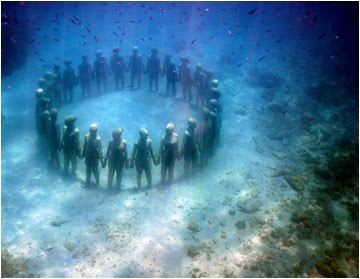

The underwater environment is much like that of the outdoors. An object is subject to changes in light and prevailing weather conditions. The cement finish and chemical composition of Vicissitudes actively promotes the colonisation of coral and marine life.
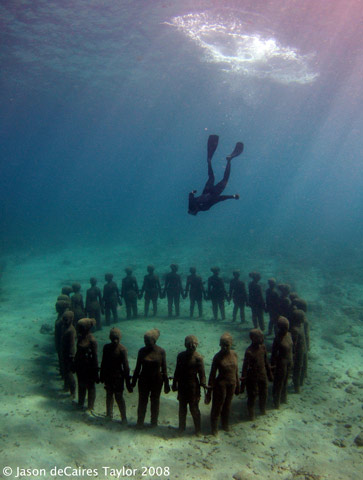

The figures are transformed over time by their environment, and conversely as this happens so they change the shape of their habitat. This natural process echoes the changes exacted through growing up. Social interchange shapes this process, while conversely as the product of a particular society we in turn invoke change on the workings and dynamics of that environment.
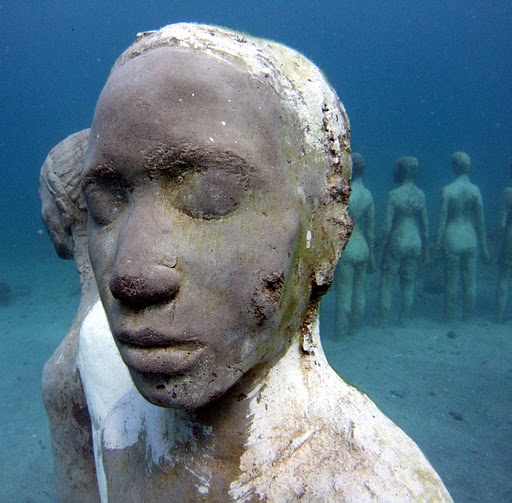

The sculpture proposes growth, chance, and natural transformation. It shows how time and environment impact on and shape the physical body. Children by nature are adaptive to their surroundings. Their use within the work highlights the importance of creating a sustainable and well-managed environment, a space for future generations. Taylor notes that close to forty percent of coral reefs worldwide has been destroyed and that this figure is set to increase. His work reminds us that the marine environment is in a constant state of flux, and that this in turn reflects poignantly the vicissitudes, changing landscapes, of our own lives.
The Un-Still Life
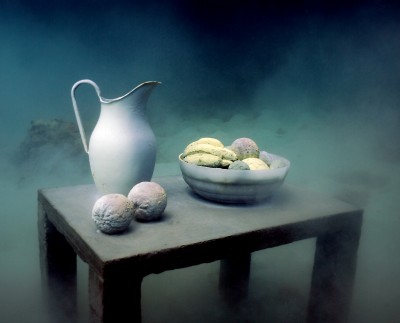

Un-Still Life mirrors the classical composition of traditional still life tableaux. On a table is an arrangement of cement objects, a vase, bowl and fruit. In contrast to established ideas of stasis the work is perpetually changing, remaining a work in progress as layers build on its surface.

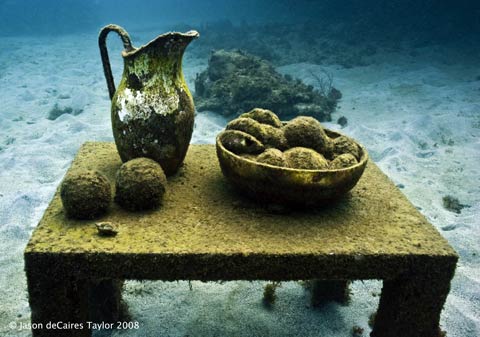
This accumulated colonisation of coral becomes a physical equivalent to conventional mark making of drawing and painting.

The work reflects the time-based observation associated with the classical study of still life composition. It reminds us that changes are inevitable.
The Lost Correspondent


The Lost Correspondent depicts a man sitting at a desk with a typewriter. The desk is covered with a collection of newspaper articles and cuttings that date back to the 1970s. Many of these have political significance, a number detail Grenada’s alignment with Cuba in the period immediately prior to the revolution.

The work informs the rapid changes in communication between generations. Taking the form of a traditional correspondent, the lone figure becomes little more than a relic, a fossil in a lost world.
Hombre en Llamas (Man on Fire)
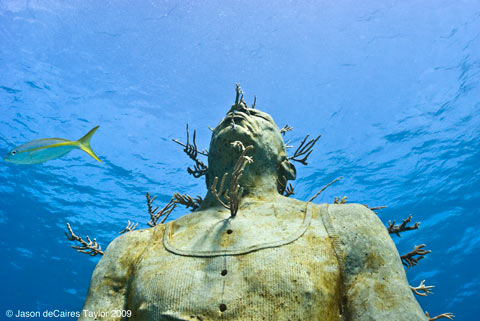
Man on fire depicts a lone figure standing upright and defiant. The sculpture is installed 8m deep in the clear Caribbean waters surrounding the island of Isla Mujeres at a location named Manchones.

The cement figure has 75 holes planted with live cuttings of fire coral (Millepora alcicorni ).This is a fast growing marine organism, yellow, orange and brown in colour which emits a painful stinging sensation when touched, thus reflecting its name and the title of the sculpture. It is anticipated that over time the figure will appear to be on fire underwater. The holes have been drilled on each profile of the body so that when the coral starts developing it will grow in pointed fingers resembling flames. Thus, when covered in coral and viewed from a distance there will appear the silhouette of a figure in flames. The fire coral has been sourced from fragments damaged by human activity or by tropical storms. A small proportion has also been artificially grown.
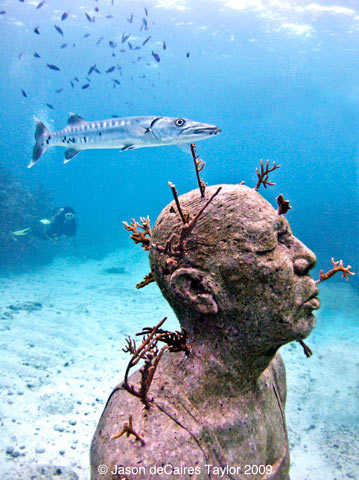
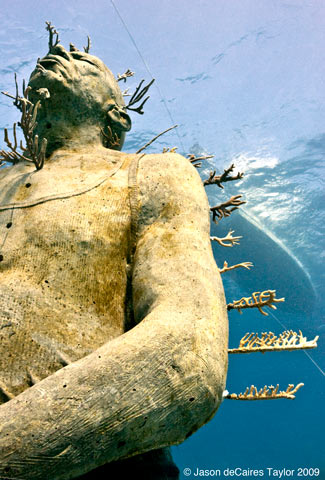
The statue, which weighs over 1 ton, is cast from a local Mexican fisherman called Joachim. The piece is intended to symbolize the current environmental situation in which we live. The man is on fire, burning but unaware of his situation, we too seem to be unaware of the impact that our actions are having on the planet on which we all live.
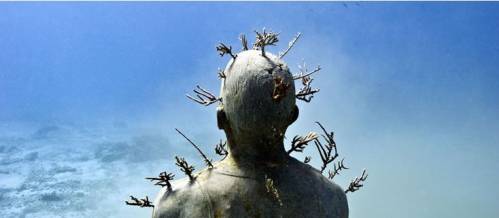
Our dependence on and over use of our limited natural resources, such as fossil fuels, has meant that we have been living on borrowed time. The fire is alight but we have the capabilities to control it, the current generation must rise to the challenge.
La Jardinera de la Esperanza (The Gardener of Hope)

La Jardinera de la Esperanza, depicts a young girl lying on garden patio steps, cultivating a variety of plant pots. The sculpture is sited four metres beneath the surface Punta Nizuc, Cancun. The pots are propagated with live coral cuttings rescued from areas of the reef system damaged by storms and human activity. This technique, a well-established procedure in reef conservation, rescues damaged coral fragments by providing a suitable new substrate.
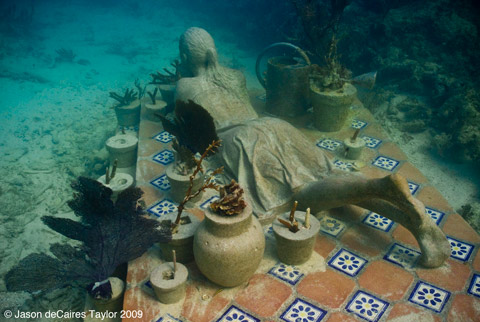

The sculpture, a synthesis between art and science, conveys a message of hope and prosperity, portraying human intervention as positive and regenerating. The young Girl symbolizes a new, revitalized kinship with the environment, a role model for future generations. The interaction between the inanimate and living forms highlights a potential symbiotic relationship with the life systems of the underwater world. Over the past few decades we have lost over 40% of our natural coral reefs. Scientists predict a permanent demise of 80% by 2050. The Gardner of Hope is designed to focus attention on this important, often forgotten, ecological issue.
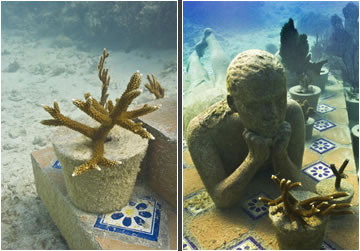
El Coleccionista de los Sueños Perdidos (The Archive of Lost Dreams) also called “The Dream Collector”
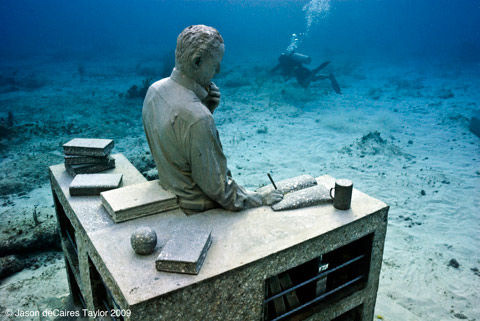
The Archive of Lost Dreams depicts an underwater archive, maintained by a male registrar. The archive is a collection of hundreds of messages in bottles brought together by the natural forces of the ocean. The registrar is collating the individual bottles and categorising the contents according to the nature of each message – fear, hope, loss, or belonging.
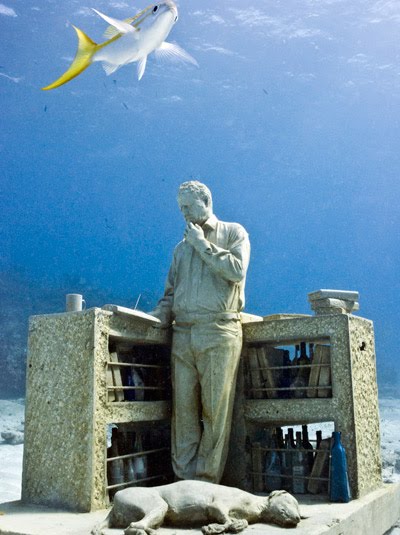

Various communities from a broad spectrum of ethnic, religious and cultural backgrounds have been invited to provide the messages, which, it is hoped, will document current values and aspirations for future generations to discover.


The sculpture is placed within an area of the national marine park, which had been previously damaged, by hurricanes and tropical storms. The choice of location aims to draw the high number of visitors to the region away from other sections of pristine reef allowing them space to develop naturally.
Fall From Grace



Limited Edition prints of his underwater sculptures are available on A2 (420 × 594mm) high grade archive photographic paper. The prints are limited to only 50 copies and are personally signed by artist Jason deCaires Taylor. Buy them here.
all images courtesy of the artist.
About the artist:

Artist’s Bio (from his own site)
Jason deCaires Taylor was born in 1974 to an English father and Guyanese mother, spending the earlier part of his life growing up in Europe, Asia and the Caribbean. Educated in South East England, he graduated in 1998 from Camberwell College of Arts, University of the Arts London, with a B.A.Honours in Sculpture and Ceramics. He is also a fully qualified diving instructor, underwater naturalist and award winning underwater photographer, with over 14 years of diving experience in various countries.
In May 2006 he gained international recognition for creating the world’s first underwater sculpture park in Grenada, West Indies. His underwater sculptures, designed to create artificial reefs for marine life to colonise and inhabit, embrace the transformations wrought by ecological processes. The works engage with a vision of the possibilities of a sustainable future, portraying human intervention as positive and affirmative. Drawing on the tradition of figurative imagery, the aim of Jason deCaires Taylor’s work is to address a wide-ranging audience crucial for highlighting environmental issues beyond the confines of the art world. However, fundamental to understanding his work is that it embodies the hope and optimism of a regenerative, transformative Nature.
Jason is currently resident in Mexico as Artistic Director of the new Cancun Underwater Museum, MUSA.
A special thanks to Jennifer Taekman and Laura Reoch of Forget Me Not Design for bringing this unusual work to my attention.


